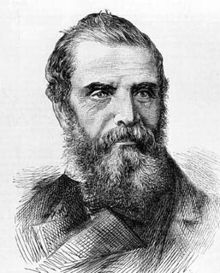Richard Ansdell
| Richard Ansdell | |
|---|---|
 |
|
| Born | 11 May 1815 Liverpool, England |
| Died | 20 April 1885 (aged 69) Surrey, England |
| Nationality | British |
| Known for | Painting |
| Notable work | Stag at Bay, Hunted Slaves |
| Website | http://www.richardansdell.co.uk/ |
Richard Ansdell RA (11 May 1815 – 20 April 1885) was an English oil painter of animals and genre scenes. He was also an engraver.
Ansdell was born in Liverpool, Lancashire, the son of Thomas Griffiths Ansdell, a freeman who worked at the port, and Anne Jackson. His father died young and Richard was educated at The Liverpool Blue Coat school for orphans. He had a natural talent for art from an early age, and after leaving school worked for a portrait painter in Chatham in Kent, and also spent time as a sign painter in the Netherlands.
He first exhibited at the Liverpool Academy in 1835, becoming a student there the following year. His animal and rural subjects proved to be popular and he soon attracted wealthy patrons. His first exhibition at the Royal Academy, London, was in 1840, with two paintings called "Grouse shooting" and "A Galloway farm". This was followed, in 1841 by "The Earl of Sefton and party returning from hunting", in 1842 "The death of Sir William Lambton at the Battle of Marston Moor", in 1843 "The Death" and in 1844 "Mary Queen of Scots returning from the chase to Stirling Castle". He went on to exhibit pictures every year at the Academy until 1885 (149 canvases in all). In 1846 he exhibited his first picture, "A Drover's Halt" at the British Institution, London, and went on to show 30 canvases there.
In June 1841, he married Maria Romer - the couple went on to have 11 children. In 1847 the family left Liverpool to live in Kensington in London.
In 1850, Ansdell started collaborating on pictures with Thomas Creswick, who specialised in landscapes (e.g.:"The South Downs", "England's day in the country" etc.). He also worked with William Powell Frith ("The Keeper's daughter") and John Phillip, with whom he travelled to Spain in 1856 and painted a series of Spanish subjects - "The Water Carrier", "The Road to Seville", "The Spanish shepherd" etc. He returned to Spain alone the following year to paint more pictures there.
...
Wikipedia
